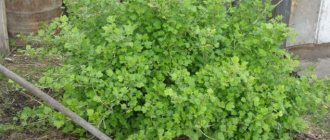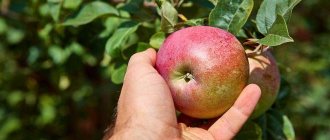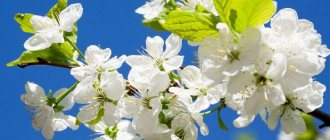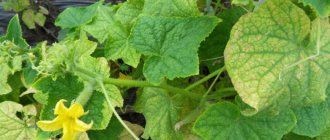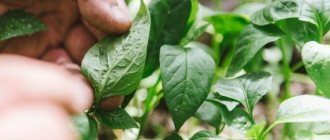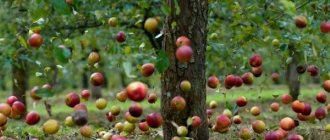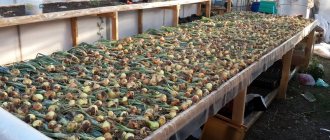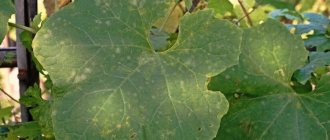How to grow blueberries - 6 common mistakes
Blueberries are called “black pearls, the berry of millionaires,” and I would call them “the berry of intellectuals.”
Blueberries are a demanding crop, but you can make friends with them. The cultivation techniques to which we are accustomed are absolutely not applicable to it: manure, ash and occasional watering... Blueberries will not grow without an acidic, loose and moist substrate. 1. Wrong choice of blueberry seedlings.
The seedlings must, first of all, be healthy, with green, spotless leaves. If you buy seedlings in early spring or late fall when the leaves have fallen and you can't tell if the leaves are healthy, pay attention to the bark. On the branches it should be free of the characteristic burgundy or brown spots, which indicates a disease called Godronia or Phomopsis.
If you happen to purchase seedlings, for example, by mail (when it is impossible to control their health) and something worries you, simply cut off the diseased branches to healthy tissue. Never buy bare-root blueberries. The plant should grow in a pot or container with an acidic substrate.
EVERYTHING YOU NEED FOR THIS ARTICLE IS HERE >>>
2. If the blueberry root ball
Do not soak or mash them before planting, then your blueberries will not grow and there will be no harvest.
Therefore, before planting, immerse the pots with plants in a container of water for 3-4 hours to saturate the lump of earth with roots with water. After this, carefully remove the plant from the pot, turn the bush over with its roots up and down (to a depth of 4-5 cm), cut the root ball crosswise or knead it with your hands, starting from the middle of the ball. Blueberries have very thin roots, Americans call them “angel hair,” and in order for them to grow to the sides, we carry out the above operation.
Place the blueberry bush in the hole prepared before planting, spread the roots to the sides and cover with the prepared substrate. Make a hole around the bush and water until completely saturated with water.
After this, mulch the hole with bark, pine litter or straw (8-10 cm layer) to reduce moisture evaporation and maintain the looseness of the substrate. In addition, soil bacteria, processing this mulch, form citric and acetic acids, which are so necessary for blueberries.
It is necessary to water the soil so that not only the soil around the blueberries is wet, but also the lump of earth in which the blueberries grew in the pot is saturated with water (even if you actively stirred it up). Otherwise, this lump of earth, densely entwined with roots (it differs in composition from the planting mixture you prepared) will remain dry in the planting hole!
The soil around the bush will be moist, and the blueberry will suffer from a lack of it (I had this happen with rhododendron, they are from the same family with blueberries: although the soil around was very moist, the bush suffered due to the fact that the root ball was completely dry). Therefore, it is very important to frequently observe the blueberries until you see that they have begun to actively grow shoots (summer growth of 50-70 cm indicates that you liked the blueberries).
It is highly advisable, if possible, to use drip irrigation to care for blueberries in the garden. When you squeeze the earth in your hand, you should feel moisture, but water should not flow.
3. The substrate for blueberries must be special.
Remove and DO NOT use all selected soil from the planting hole. Because you probably once introduced ash, manure, or bird droppings into your garden, but blueberries absolutely cannot stand it! Fence the dug hole with boards and logs (you need to do this to make it easier for you to maintain the necessary soil acidity and moisture) and fill it with a previously prepared substrate of high-colored red peat, pine litter, bark, sand, and old sawdust.
Take half a sugar bag for each component; it should be enough for one bush. On light soils, where there is no likelihood of water stagnation, a hole is dug 40-50 cm deep and 70-80 cm wide.
On heavy loamy soils, the holes are made wider and shallower (25-30 cm) and the bushes are planted on a small hill (do not forget to fence and mulch after planting). Low-growing varieties are planted at a distance of 0.8-1 m from each other, medium- and
vigorous - at a distance of 1.2-1.5 m.
We do not use mineral fertilizers on the plantation on our farm, but proper agricultural technology can successfully replace them.
4. Wrong choice of planting site for blueberries.
Blueberries love the sun and do not like the wind. The place should be open and sunny. To protect from the wind from the north side, you can offer a fence, a screen made of agro-fabric or a hedge. A fence 1 m high breaks the wind by 10 m, that is, behind a fence 1 m high there will be no strong wind, which manages to wear off the bark on the branches, where infection can then easily enter. Ripening berries lose their delicious blue tinge due to the wind and are poorly stored.
5. Incorrect soil acidity for blueberries.
For blueberries, it should be between pH 4 and 5.5. This is a very important indicator, otherwise the bushes will not grow and bear fruit well. Usually the acidity of the soil on our acres is pH 6-7; you can acidify the soil to a better value with colloidal sulfur, which is sold in garden stores. 1-2 tbsp. spoons around the bush will be enough. Soil bacteria oxidize sulfur, resulting in the formation of sulfuric acid, which causes a decrease in pH. Sulfur is usually applied in the spring, but for good results the soil must be moist and well aerated. Acidify the soil in the future (if blueberries do not produce good (50-70 cm) growth and the foliage has a light green tint), preferably with oxalic acid - 0.5 teaspoon per 1 bucket (10 l) of water.
6. Blueberries do not like crowded conditions.
The distance between the bushes should be at least 1 m so that each berry has enough sun and warmth.
Planting and caring for blueberries - personal experience
My first experience of planting blueberries was unsuccessful. After analyzing the mistakes, I discovered this culture in a new way.
Further care of the plant
After planting, to obtain a good harvest, the plant should be provided with proper care. In its absence, the bush begins to hurt, bears fruit worse, the berries become smaller and lose their taste.
Loosening and weeding
When starting to care for blueberries, you need to pay special attention to loosening the soil and weeding. The roots of these berry bushes are superficial and will not be able to develop well without these procedures.
Weeds will suck moisture and nutrients from the soil, causing blueberry deficiency. Lack of loosening will lead to deterioration of root respiration.
Weed the plantings as needed. It is better to do weeding in the evening. Loosening is carried out after watering, before mulching. Since the roots are close to the surface, you cannot loosen them deeply so as not to damage them.
Watering
At the dacha, blueberries should be watered at least once a week, and in dry weather at least 2 times a week. 20 liters of water are poured onto one bush. The soil should not dry out, as in this case the plant will die, but stagnation of water is also unacceptable for it, in which case it will get wet.
Expert opinion
Stanislav Pavlovich
Gardener with 17 years of experience and our expert
Ask a Question
Important! To understand whether it is time to water blueberries, you need to check the soil moisture at a depth of 2 cm; if the soil turns out to be dry, then watering is necessary. To slow down the evaporation of water from the soil, it is recommended to mulch it
You can use sawdust or straw for this.
To slow down the evaporation of water from the soil, it is recommended to mulch it. You can use sawdust or straw for this.
Soil acidity level
The acidity level of the soil will be checked using test strips. If it is insufficient, then acidification is necessary. For this purpose, use a solution of citric acid. It is dissolved in an amount of 25 ml in 10 liters of water. Water the soil around the plant with this solution, covering the entire intended root area. This procedure is needed in the spring, when melt water can reduce the acidity level of the soil. It is also carried out in the summer, if due to heavy rains the acidity is insufficient.
Top dressing
Feeding begins in the second year after planting the plant in a permanent place. In the spring, at the beginning of the growing season, a complex mineral composition for fruit bushes is applied. It is used according to the manufacturer's instructions. Feeding is carried out during the period of swelling of the buds. Mineral fertilizers are applied again after 45 days. The use of organic fertilizers for blueberries is unacceptable.
Trimming
Pruning allows you to form the right bush that will fully bear fruit. For this purpose, pruning is done annually during the first 4 years of blueberry growth in a permanent place. A sparse middle is formed in the bush, and all branches growing towards the center of the crown are removed. Shoots that are located very low to the soil and those that are damaged are also cut off. Weak shoots are not left, as they only interfere with the development of full-fledged skeletal branches, on which most of the harvest will be formed.
After 4 years, pruning is carried out for sanitary purposes in the spring, removing dead and broken branches in winter. Shoots older than 5 years are also cut off, since the berries on them are small.
How to understand what a plant is missing
You can tell that a bush is lacking nutrients by its appearance. You need to be guided by the following signs:
- slow development and yellowing of leaf blades – nitrogen deficiency;
- blackening of the tops of the shoots and drying of the ends of the leaves - potassium deficiency;
- pale tint of leaves with whitishness - lack of sulfur;
- bluish leaf color – boron deficiency;
- drooping of the plant - lack of water or its excess;
- general stunted appearance - insufficient soil acidity.
All these problems can be easily eliminated if attention is paid to them in a timely manner.
Preparing for winter
Moving (transplanting) adult bushes to a new location is carried out in the fall after the leaves fall, when, like young plants, they require special preparation for the winter period. Adult blueberries overwinter normally at temperatures down to -25 degrees. Even in case of severe freezing, the plant recovers quickly.
Before the onset of frost, you need to carry out a single watering. After this, the branches of the bush are tied and bent to the ground. Then the plant is covered with spruce branches. The soil around the bush is also protected with spruce branches. You can open blueberries early in the spring, as the bushes easily tolerate frosts down to -7 degrees without any protection. Because of this, returning spring frosts do not pose a danger to them.
Why blueberries don’t bear fruit and what to do, reasons and solutions
Growing berries on a personal plot has long become a habit. But the cultivation of unusual, less common species primarily evokes interest or even excitement. After all, who doesn’t want to admire a beautiful bush with rare, tasty and healthy berries. But such bushes are a risk. After all, even after maximum efforts, they are not happy with the harvest. Why blueberry plantings do not bear fruit and what to do to make the plant begin to bear fruit.
Why blueberries don’t bear fruit or bloom: reasons and solution to the problem
Situations arise when, despite all the efforts to care for blueberries, flowering and fruiting do not occur. To understand why garden blueberries do not bloom, you need to observe the plant. Perhaps mistakes were made during planting or during the care process. And there are enough factors influencing the fruiting of a bush.
Violation of agricultural technology
An important factor in the appearance of flowers and fruiting of a plant is compliance with the rules of agricultural technology. This shrub grows poorly in beds where there were previously potatoes or other vegetables. Herbs are recognized as the best predecessors, and they are also perennial. The plant does not like organic matter, so soils that have not been added to organic matter for the last five seasons are suitable.
Failure to follow planting rules is also an important factor. When purchasing, you must choose a copy that is in a large container. In small pots, the roots of the plant are densely intertwined and rolled inward.
Rules for planting shrubs:
- Soak the container with blueberries for a quarter of an hour.
- Remove the pot and straighten the roots of the plant, since they will not straighten on their own. If you plant it as is, then after some time when digging it up you will find that the root system has remained in the same form. Blueberries planted in this way will not only not bear fruit, but will die over time.
The root system of the shrub is located shallow, almost in the surface layer, no deeper than 0.25 m. Accordingly, a hoe or similar equipment is not used in the process of weeding the plant. A damaged root system will not recover. The soil is not loosened deeply, 30-35 mm.
Planting bushes in the shade
The shrub does not bloom if planted in a shaded area. Although this is a familiar environment for it and it takes root well in the shade, the plant needs light to bear fruit. In this case, the place should be illuminated by the rays of the sun and protected from draft winds.
Unsuitable soil acidity
The acidity level should be up to 3.5-4.5. To obtain such soil, it is recommended to use sulfuric or sulfuric acid. And to acidify the soil, you can use 9% acetic or malic acid at a rate of 120 ml per 10 liters of liquid.
Lack of mulch
Mulching with sawdust, bark and tree needles helps enrich the soil, creates an air-water balance for the development of the plant's root system, helps maintain the required level of acidity, and prevents the appearance of weeds. Recommended layer thickness is 5-8 cm.
It has been proven that mulching promotes plant development and increases yield. One of the advantages of mulch is the ability to retain moisture, cool the soil in hot weather and heat during winter (the roots are protected from frostbite).
Insufficient drainage
If the soil is heavy and groundwater is nearby, blueberries must be planted on a ridge. It is necessary to extract a part of the soil 50-80 mm deep. Place it around the planting hole. Fill the hole with peat or peat-sand mixture. You can add sawdust and pine needles. You should get a hump, on the top of which place a blueberry bush, sprinkle with soil, and mulch the soil.
As a result, excess liquid will flow down the surface of the slide, and the plant’s root system will receive air and water in a balanced manner.
Planting only one bush
To improve productivity, it is recommended to plant at least two varieties of blueberries, then there will be a lot of berries.
Bacterial and infectious diseases
A sick plant, weakened by infectious or bacterial diseases, will not bear fruit. For prevention, it is recommended to treat with fungicides in spring and autumn.
At the beginning of spring it is treated with Polycarbacin 1%, Bordeaux mixture, Rovral 1%. When the foliage blooms, treat with a fungicide (Topsin M, Euparen, Kuprozan, Benomil, Rovral). Treatment is carried out three times every 7-10 days.
After removing the berries from the bush, they are treated with fungicides three times, the last after the leaves fall.
Double leaf spot
Appears exclusively on leaf blades. At the end of March, a small number of small light, brown, gray, dark spots with a diameter of 2-3 mm are formed, but soon there are more of them. In summer, the formations begin to expand, reaching a diameter of 6 to 13 mm. The stain becomes, as it were, double: the previous one and the new one, much darker. In rainy weather the disease spreads much faster.
Topsin and Euparen are recognized as effective drugs for treatment. In the spring and autumn periods it can be treated with Rovral.
Stem cancer
The most harmful disease of this nature. The disease has the following symptoms. First, red spots form on the scars of the leaf blades and on the sprouts. Over time, they become larger, take on an oval shape and darken. Then the spots grow, connect with each other, cover the entire surface of the shoot, and it dies. Young shrubs are more quickly affected by this disease. On old shoots, ulcers appear with the bark cracking and falling off.
Prevention is important above all. It is not recommended to plant in beds where there is high humidity, and do not apply large amounts of nitrogen-containing fertilizers. Promptly cut off disease-damaged branches and destroy them.
For treatment, it is recommended to use “Topsin” (0.2%), “Euparen”. Carry out the treatment three times, every 7 days. The first treatment is before flowering, the second after harvesting. Treat with Bordeaux mixture after the foliage blooms, in the autumn - twice after falling.
Parasitization of the fungus Phomopsis
The symptoms of the disease are similar to stem cancer. New shoots begin to dry out and curl. The length of the lesion varies from 3 to 35 cm. The foliage becomes brown, dries out, falls off, and red spots measuring 10 mm in diameter form on it.
Prevention measures
Knowing all the intricacies of caring for blueberries, you can achieve fruiting in just a couple of years. To do this, you need to periodically check the condition of the bushes. Preventive measures should include:
- regular feeding with minerals;
- updating mulch;
- cutting off dead branches;
- spring protective treatment of the plant with natural aseptics (onion water, soap solution, etc.);
- monitoring soil acidity and moisture;
- covering the bush for the winter to protect against frostbite.
Periodically carrying out the above work will help maintain optimal conditions for blueberry growth and development. The result will be a bountiful harvest.
Why don't garden blueberries bear fruit?
When buying garden blueberries, every amateur gardener hopes that next year the plant will begin to bear fruit abundantly and delight with its fruits.
However, this is often not the case - blueberries grow fully and even bloom, but neither this year nor the next, and for quite a few years now they have not brought any fruit to their owners! Perhaps the soil on which the plant was planted and the climate of these places are completely unsuitable for growing garden blueberries. Then why are there blueberries with a lot of berries on the neighboring plot? Let's find out!
Reasons for the lack of fruiting of garden blueberries
- Young blueberries, no matter how well they are cared for, begin to bear fruit no earlier than in the third year, but fruiting will be abundant only five years after planting.
- Blueberries should be grown exclusively in acidic soils. If your area does not have such features, the plant, of course, will grow, but it will not have enough strength and the necessary substances to bear fruit. In this case, it is recommended to water the plant directly under the roots with acidified water at least once a month. It is not difficult to prepare such water - just put a small pack of citric acid in a bucket of water and stir. It is advisable that this solution does not come into contact with other parts of the plant except the roots.
- The fruiting period will be delayed for a long time for blueberries that have recently been transplanted, and incorrectly. If, when replanting a plant, the root system is disrupted, and this is exactly what happens when a lump of earth falls away from the roots, then it will take a lot of time to restore normal life.
- Blueberries do not bear fruit due to some disease that disrupted the process even during the flowering of the plant or the immediate fruit set.
- If the garden blueberries bloomed right at the last spring frosts, then fruiting will be weak, and in the worst case, it threatens its complete absence.
- Blueberries bear fruit from shoots that grew last year. If you unknowingly performed incorrect pruning or untimely pruning, then there will be no fruit. Therefore, it is necessary to remove only frozen parts of the plant; if there are no such branches, it is better not to prune at all.
- The lack of periodic feeding can lead to the fact that the plant completely stops bearing fruit for a while.
- Garden blueberries love a sunny location and abundant watering, which should be timely.
- Blueberries bear fruit well in high humidity, which is why blueberries may not bear fruit in areas where there is constant wind and drought.
As you can see, garden blueberries are a very capricious plant. However, if everything is done correctly, then this beauty will become a wonderful ornamental plant on your site and will bear fruit just as well! Moreover, it is hardly possible to find another perennial plant like garden blueberry! With normal cultivation and proper care, your blueberries will decorate your garden for at least 30 years!
Viral lesions
In addition to the listed diseases of a fungal nature, there are also those whose nature is viral or mycoplasmal in nature. These are dwarfism, filamentous branches, mosaic, necrotic spot and red ring spot. When such diseases appear, there is nothing left to do but completely remove and burn the affected plants. To know these ailments in person, we will describe each of them.
Dwarfism
Disease caused by mycoplasma. Plants affected by dwarfism grow poorly and produce small and tasteless fruits. The leaves also become smaller and then turn yellow prematurely. At the end of the summer period, the yellowish spots begin to turn red.
Threadiness of branches
It is complicated by the fact that it can proceed covertly for four years. During the period of manifestation of the disease, plant growth slows down, the leaves turn red, then wrinkle and begin to curl. On the shoots you can see stripes similar to laces.
Mosaic
A mosaic yellowish pattern appears on the leaves. Near the cuttings they turn yellow, and at the tops they turn green. This disease is transmitted by ticks.
Necrotic spotting
You can notice red spots in the form of a ring on the leaves, and most often the older leaves are affected first. Having occupied part of the plant, the disease after some time affects it entirely.
Red ring spot
At the end of June, red ring spots appear on the leaves (most often on old ones). Like the previous ailment, this one starts small, then spreading throughout the entire plant.
The reasons for poor blueberry development or lack of harvest can be completely different. And if errors during cultivation can be corrected in a short time, then if they are affected by diseases, efforts must be made over a long period of time. This is provided that you are not dealing with viral diseases. In this case, you will have to get rid of the diseased plants and hope that the next plantings will avoid such a nuisance. The main rule remains the following: the more accurately you determine the cause of the problem and the sooner you take active action, the greater the chances of a positive outcome.
MAJOR MISTAKES WHEN GROWING BLUEBERRY
The first mistake: blueberries grow in a swamp, so they should be planted in lowlands where water stagnates, or create conditions with increased soil moisture.
In no case! Blueberries grow along the edges of swamps or on hummocks, where drought rather than excess moisture occurs. Roots need not only water, but also air to breathe, and for blueberries this is especially important. In addition, in the lowlands there are often frosts, which damage young shoots, flowers, ovaries, and berries in the fall. Therefore, blueberries should be planted in an area where the threat of frost is minimal, with moderate moisture and avoid stagnation of water.
Mistake two: blueberries grow under the forest canopy, which means they need to be planted in shady places on the site.
Blueberries grow in shaded areas, but do not bear fruit. To produce a harvest, it needs good lighting. Therefore, blueberries must be planted in a well-lit, sunny place, protected from the wind.
Error three: I have acidic soil on my plot because it is on a peat bog, horse sorrel, woodlice, etc. grow.
Diseases and their treatment
Stem cancer (fungal origin)
Symptoms: Small red spots appear in the area of leaf scars on the shoots. Gradually they grow, acquiring an oval shape and darkening. The spots grow, merge with each other, capturing the entire shoot and leading to its death. A young plant can be completely destroyed by this disease, so it is important not only to treat it as quickly as possible, but also to prevent it.
Treatment: Do not plant blueberries in areas with excessive moisture, and do not feed them with nitrogen fertilizers. Regularly prune and burn disease-damaged shoots. It is recommended to use topsin (0.2% solution) or euparen (same concentration) as treatment. This composition is sprayed three times with an interval of 7 days before flowering and after harvesting. Bordeaux mixture is also suitable, used according to the instructions - in the spring, before the leaves bloom, and in the autumn after they fall - 2-3 times.
Why don't blueberries bear fruit?
Following the rules for planting garden blueberries in the spring , we hope that the plant will quickly bear fruit, but after waiting several years for development, we do not get any berries. Observing the berries and comparing them with common causes of violations will help determine why blueberries do not bear fruit.
Why blueberries do not bear fruit:
- The problem is the acidity of the earth;
- Young berry;
- Frost;
- Diseases;
Garden blueberries do not bear fruit in neutral or alkaline soils . For fruit to appear, it is recommended to acidify the soil. If the soil in which blueberries were planted in the garden was initially acidic and remains so - how to find out the acidity of the soil - then you need to look for other reasons or take an integrated approach to solving problems. Please note: blueberries may also not bear fruit on acidified soil. Soil acidity for blueberries: 3.5 – 4.5 pH.
Young, underdeveloped blueberry,
may not have reached the period when it is ready to bear fruit.
At a young age, other problems may be added - insufficient soil pH, overwatering, diseases - which only delays the expected appearance of berries. When does blueberry begin to bear fruit: in the 3rd year from the moment of planting in the ground. However, fruiting is a separate issue. The young berry should bloom . If there was no flowering, look for a violation in other reasons: why don’t blueberries bloom?
Viral lesions
Fungal diseases are not the only ailments that plague the plant. Some of them are viral in nature. When affected by such a disease, treatment is useless. All that remains is to remove and burn the affected plant. It is important to learn to determine the nature of the disease.
Mosaic
Yellowish patterns form on the leaf blades of the plant. Near the cuttings they are yellow, closer to the tops they are greenish. The disease is carried by ticks.
Threadiness of branches
The complexity and danger of this disease lies in the fact that in a latent state it can last for about four years. When affected, the growth rate of the plant decreases, the leaf blades turn red, then wrinkle, and gradually begin to curl. The sprouts have stripes similar to laces.
Red ring spot
By mid-summer, reddish spots form on the leaf blades of the plant, often on older ones. The defeat begins with the leaves and gradually spreads to the entire plant, completely destroying it.
Dwarfism
This disease is caused by mycoplasma. A diseased plant grows poorly, hence the name. The branches bear small, tasteless berries, or there are none at all. Gradually the leaves become small, then turn yellow, and at the end of summer the yellowed leaves turn red.
Necrotic spotting
With this disease, red ring-shaped spots are visible on the leaves of the plant. The lesion first spreads to older leaves. Afterwards the plant is completely affected.
There are many reasons for the slow development of the bush and the lack of berries. If this is a violation of the rules of agricultural planting or care, this can be corrected in a fairly short time. If a plant is affected by a disease, you will have to spend a lot of effort and time to save it. If the disease is viral in nature, the plant cannot be saved. The main thing is to correctly and timely determine the cause of the current situation and, without delay, try to save the plant. Only then can you expect the desired results.
Mistake 4. Irregular or excessive watering
When growing blueberries, you need to maintain a strict balance when watering the bush: on the one hand, you must not allow the top layer of soil to dry out, and on the other, you must avoid stagnation of water, otherwise the plant may die. Blueberries need about the same amount of water as other crops.
Water blueberries 2 times a week, using 1 bucket of water per adult bush. In this case, pour out the water in 2 doses: early in the morning and in the evening of the same day after sunset. In the second half of summer, it is especially important to monitor watering, since the lack of moisture during ripening of berries negatively affects the quantity and quality of not only the current, but also the future harvest, because flower buds are formed on the shoots of the current year.
In dry weather, not only water the blueberries more often (three times a week), but also spray the crown of the bushes with water at the hottest time (at about 12-13 and 15-16 hours). This technique will help plants cope with stress and improve the process of photosynthesis.
